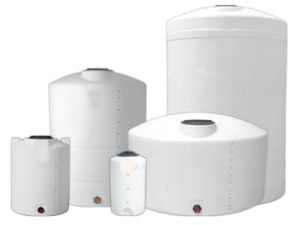Sodium Hypochlorite Storage Tanks
Tanks for Sodium Hypochlorite must be able to withstand the aggressive nature of the chemical involved.
Steel vs. Fiberglass vs. Poly?
Since Sodium Hypochlorite is such a poor match for steel tanks, the natural choices have been either plastic or fiberglass. Fiberglass tanks offer about the same lifespan as plastic tanks when used for storage of Sodium Hypochlorite but cost 30 to 40% more and require great care against damage in shipping and use. As a result, Polyethylene tanks hold much of the Sodium Hypochlorite used by industry and water treatment operations today.
Are there differences in Polyethylene’s?
When you start looking for the right Polyethylene tank for storage of Sodium Hypochlorite, pay attention in the details. While resin maker Exxon has done studies with the University of Nebraska, some tank makers continue to go against recommendations from Exxon that result from that study. As a result, you could make a bad choice of tank materials and end up getting a tank that has a shorter useful life than is otherwise available.
High Density Polyethylene versus Crosslink Polyethylene.
There are several variations of Polyethylene. The two that come into play with Sodium Hypochlorite are High Density Polyethylene and Crosslink Polyethylene. Crosslink is an older type of polyethylene that is more expensive, not recyclable and is not ‘weld-able’ using thermoplastic welding. It has advantages when it comes to the storage of a few chemicals but, according to Exxon, it is not the best choice for tanks that will store sodium hypochlorite. Exxon’s study shows clear benefits from using High Density Polyethylene for the storage of Sodium Hypochlorite. You can read the Exxon report by clicking here.
Tank Location makes a difference!
Beyond the selection of High Density Polyethylene as the material for the tank, the planned location also affects tank details.
Indoor:
Indoor Tanks where exposure to Ultra Violet rays will be low can be manufactured from Natural color resin. It is a translucent white and since you can see the level of the liquid, there is no need for a sight gauge. Indoor Tanks where exposure to Ultra Violet rays will be moderate can be made from Black colored resin. The fill level will not be visible so a sight gauge or other level indicator is a very good idea.
Outdoor:
Outdoor tanks can be made from Natural color resin if they are going to be coated with polyurethane foam insulation and covered with a mastic coating. Fill level is not visible through the foam. Outdoor tanks that will not be coated with insulation should be opaque. Depending on the climate and degree of exposure to direct sunlight, either a black or opaque white tank could be suitable.
What grade of tank?
Polyethylene tanks are manufactured and rated based on the weight per gallon of the liquid they are able to hold. Beyond the weight of the liquid, other factors such as the effect of the chemical on the tank over time must be taken into account. We recommend using tanks with a specific gravity of 1.9 or higher for storing Sodium Hypochlorite.
What about Fittings?
Fittings selection is just as important as tank selection, attention needs to be given to their material of construction, size, location, connection type and can be a separate discussion in their selves.
Contact us and let our experienced staff assist with providing the right tank for your application.

